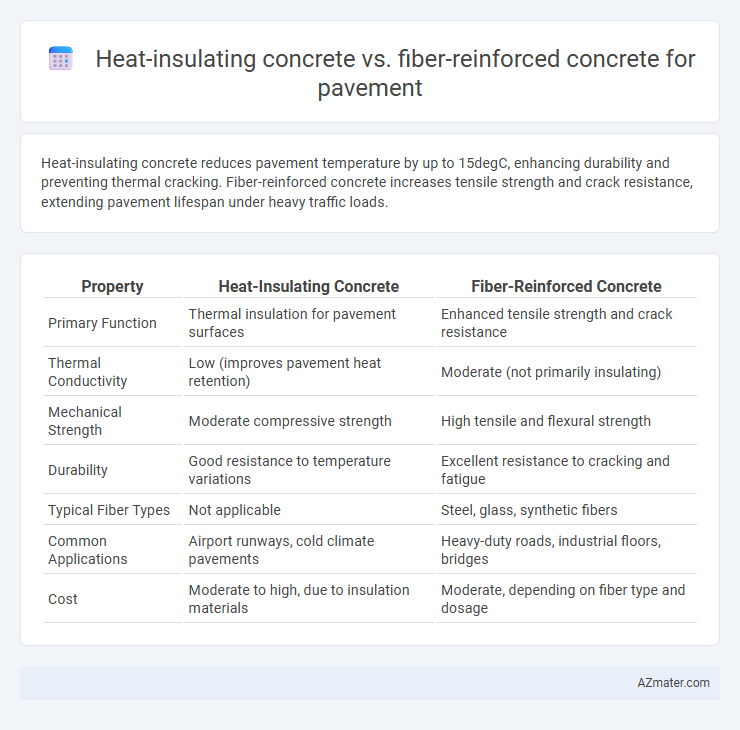Heat-insulating concrete reduces pavement temperature by up to 15degC, enhancing durability and preventing thermal cracking. Fiber-reinforced concrete increases tensile strength and crack resistance, extending pavement lifespan under heavy traffic loads.
Table of Comparison
| Property | Heat-Insulating Concrete | Fiber-Reinforced Concrete |
|---|---|---|
| Primary Function | Thermal insulation for pavement surfaces | Enhanced tensile strength and crack resistance |
| Thermal Conductivity | Low (improves pavement heat retention) | Moderate (not primarily insulating) |
| Mechanical Strength | Moderate compressive strength | High tensile and flexural strength |
| Durability | Good resistance to temperature variations | Excellent resistance to cracking and fatigue |
| Typical Fiber Types | Not applicable | Steel, glass, synthetic fibers |
| Common Applications | Airport runways, cold climate pavements | Heavy-duty roads, industrial floors, bridges |
| Cost | Moderate to high, due to insulation materials | Moderate, depending on fiber type and dosage |
Introduction to Advanced Concrete Technologies for Pavement
Heat-insulating concrete enhances pavement performance by reducing thermal conductivity, thereby minimizing surface temperature fluctuations and mitigating heat-related distresses such as rutting and cracking. Fiber-reinforced concrete improves pavement durability through the integration of synthetic or steel fibers, which increase tensile strength, flexural toughness, and resistance to fatigue and shrinkage cracks. Combining advanced materials and mix designs, these concrete technologies optimize longevity and maintenance efficiency in modern pavement engineering.
Key Properties of Heat-Insulating Concrete
Heat-insulating concrete for pavement features low thermal conductivity and high insulation capacity, reducing heat transfer and mitigating pavement surface temperature fluctuations. Its lightweight composition often incorporates insulating aggregates such as expanded perlite or polystyrene beads, enhancing durability while maintaining structural integrity. In contrast to fiber-reinforced concrete, which primarily improves tensile strength and crack resistance, heat-insulating concrete prioritizes energy efficiency and temperature regulation properties essential for urban heat island mitigation.
Key Properties of Fiber-Reinforced Concrete
Fiber-reinforced concrete (FRC) for pavement demonstrates enhanced tensile strength, improved crack resistance, and superior durability compared to traditional heat-insulating concrete. The inclusion of fibers such as steel, glass, or synthetic types significantly increases toughness and reduces shrinkage, leading to longer pavement lifespan under heavy traffic conditions. FRC's ability to maintain structural integrity and resist impact and fatigue makes it an optimal choice for high-performance pavement applications.
Comparative Thermal Performance in Pavement Applications
Heat-insulating concrete exhibits superior thermal resistance with lower thermal conductivity values, typically ranging from 0.12 to 0.25 W/m*K, effectively reducing heat transfer and limiting pavement temperature fluctuations. Fiber-reinforced concrete, while enhancing mechanical properties such as tensile strength and crack resistance, usually has higher thermal conductivity, around 1.2 to 2.0 W/m*K, leading to increased heat absorption and faster temperature changes. For pavement applications, heat-insulating concrete minimizes heat-induced thermal stresses and urban heat island effects, whereas fiber-reinforced concrete provides improved structural durability but less thermal performance.
Structural Strength and Durability Differences
Heat-insulating concrete typically offers enhanced thermal resistance but has lower compressive strength and toughness compared to fiber-reinforced concrete, which incorporates synthetic or steel fibers to significantly improve tensile strength and crack resistance. Fiber-reinforced concrete demonstrates superior durability under dynamic loads, freeze-thaw cycles, and abrasion, making it more suitable for high-traffic pavements requiring structural resilience. The structural strength advantage of fiber reinforcement translates into extended pavement service life and reduced maintenance costs, whereas heat-insulating concrete is often prioritized for minimizing thermal stresses in pavement subsurfaces.
Installation and Workability Considerations
Heat-insulating concrete offers enhanced thermal protection and easier handling due to its lightweight composition, facilitating faster installation in pavement projects. Fiber-reinforced concrete improves tensile strength and durability but requires careful mixing and placement techniques to ensure uniform fiber distribution and prevent clumping. Workability challenges with fiber-reinforced concrete demand specialized equipment and skilled labor, potentially increasing installation time compared to the more straightforward application of heat-insulating concrete.
Longevity and Maintenance Requirements
Heat-insulating concrete for pavement offers enhanced thermal regulation, reducing temperature-induced stress and thus extending pavement longevity by minimizing cracks and deformation. Fiber-reinforced concrete significantly improves tensile strength and crack resistance, leading to lower maintenance needs and better durability under heavy traffic loads. Both materials reduce maintenance frequency, but fiber-reinforced concrete typically requires less frequent interventions due to its superior mechanical properties.
Environmental Impact and Sustainability
Heat-insulating concrete reduces urban heat island effects by lowering surface temperatures, contributing to energy savings and a smaller carbon footprint. Fiber-reinforced concrete enhances pavement durability and reduces maintenance frequency, resulting in less resource consumption and lower greenhouse gas emissions over the pavement lifecycle. Both materials improve sustainability, but heat-insulating concrete prioritizes thermal regulation while fiber reinforcement emphasizes structural longevity.
Cost Analysis: Heat-Insulating vs Fiber-Reinforced Concrete
Heat-insulating concrete typically incurs higher initial costs due to specialized materials designed to reduce thermal conductivity, which improves pavement durability by minimizing thermal cracking. Fiber-reinforced concrete can offer cost savings over time through enhanced tensile strength and reduced maintenance needs, despite slightly higher material expenses compared to conventional concrete. Life-cycle cost analysis often favors fiber-reinforced concrete for heavy-traffic pavements, while heat-insulating concrete is economically justified in regions with extreme temperature variations requiring thermal protection.
Selecting the Right Concrete Type for Pavement Projects
Heat-insulating concrete improves pavement energy efficiency by reducing thermal transfer, ideal for regions with extreme temperature variations, while fiber-reinforced concrete enhances structural durability and crack resistance, crucial for high-traffic or load-bearing surfaces. Selecting the right concrete type depends on project requirements such as climate, load demands, and maintenance goals; incorporating thermal insulation benefits or mechanical strength should align with long-term pavement performance objectives. Evaluating factors like thermal conductivity, flexural strength, and lifecycle costs ensures optimized pavement solutions for longevity and safety.

Infographic: Heat-insulating concrete vs Fiber-reinforced concrete for Pavement
 azmater.com
azmater.com